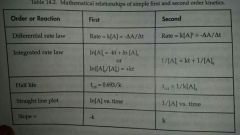![]()
![]()
![]()
Use LEFT and RIGHT arrow keys to navigate between flashcards;
Use UP and DOWN arrow keys to flip the card;
H to show hint;
A reads text to speech;
21 Cards in this Set
- Front
- Back
- 3rd side (hint)
|
Dilution equation
|
M1V1=M2V2
|
|
|
|
Reaction rate
|
Is a measure of speed of a chemical reaction. U.O.M.: (M/s)
|
|
|
|
Concentrations of reactions
|
Higher concentrations of reactions produce a faster reaction. []^, the F of collisions ^, ^ reaction rate.
|
Affects reaction rate
|
|
|
Temperature
|
Increasing temp. increases reaction rate. ^temp=^KE= molecules moving faster= more collisions. Also ^ fraction of collision.
|
Affects reaction rate
|
|
|
Physical state of reactants
|
Homogenious mixtures of liquids or gases react faster. solids go slower because less collisions an increase in surface area will increase the frequency of collisions and increase the reaction rate.
|
Affect reaction rate
|
|
|
The presence of a catalyst
|
Catalyst increases the rate of reaction by affecting the kinds of collisions that lead to a reaction. Catalyst ask for a change in the mechanism of the reaction.
|
Affect reaction rate
|
|
|
Reaction order
|
The sum of the exponents M and N in a rate law.
|
Rate= K [A ]^M[B]^N
|
|
|
First order reaction
|
A reaction who's rate depends on the concentration of a single reactant raised to the first power (graph appears as a straight line).
|
|
|
|
Second order reaction
|
Whose rate depends on the concentration of the reactants raised to the second power ( graph appears to be straight ).
|
|
|
|
Half life
|
The time required for the initial concentration of a reaction to fall to half its value
|

|
|
|
Activation energy (Ea)
|
The minimum amount of energy required to imitate a chemical reaction.
|
|
|
|
Activated complex
|
Highest energy arrangement of molecules as they change from reactants to products.
|
|
|
|
Catalyst
|
Lowers the activation energy of a chemical reaction and increases the rate of the reaction.
|
|
|
|
Reaction mechanism
|
Step by step process by which a chemical reaction occurs.
|
|
|
|
Elementary step
|
Each single event or step in a mechanism
|
|
|
|
Molecularity
|
The number of molecules that participate as reactants in an elementary reaction.
|
|
|
|
unimolecular
|
Elementary reaction involves one reactant molecule.
|
AB ---> A+B the rate law: 1st order
rate = k [AB] |
|
|
Bimolecular
|
Elementary reaction involves the collision of two reactant molecules.
|
A+B---> AB rate law: 2nd order
rate=k [A][B] |
|
|
Termolecular
|
Reaction involves the simultaneous collision of 3 reactant molecules.
|
A+B+C---> ABC rate law: 3rd order
rate=k[A][B][C] |
|
|
Intermediate
|
A chemical species that is formed in one elementary step of a multi step mechanism and consumed in another.
|
|
|
|
Rate determining step
|
The slowest step of a multi step mechanism and governs the rate of the overall reaction
|
|

